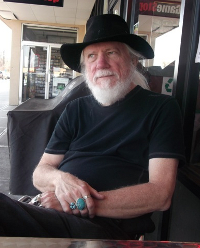Robert Connelly
|
Bob Connelly is a mathematician specializing in discrete geometry and rigidity theory. He is best known for discovering embedded flexible polyhedra. One such polyhedron is in the National Museum of American History. He is currently a professor at Cornell University. His recent interests include tensegrities and carpenter's ruler problem which can be resumed as this: Can a simple planar polygon be moved continuously to a position where all its vertices are in convex position, so that the edge lengths and simplicity are preserved along the way? |
 |
"Jammed packings in the plane": If you have ever driven behind a truck carrying a load of pipes, you might wonder if they if they were secured safely. You should. There are ways to do it that are stable, and ways that are not, and the distinction can be fuzzy. The pipes are essentially packings of circular disks in a planar box. The most dense packing of an infinite number of equal disks in the plane is known. But for pipes and granular materials it is enough that packing be the most dense only for small perturbations of the arrangement. The property of being rigid means that the the packing is jammed, and whether a packing is jammed can be calculated for reasonable containers. Many interesting containers for circle packings are not boxes but tori, what you get by identifying the left and right sides, and the top and bottom, of a box in the plane so the boundary effects are avoided. There are interesting examples of jammed and not jammed packings of a finite number of circular disks in a torus that have been found by groups of undergraduate students at Cornell and Grand Valley University in Michigan. Their results will be presented.
"Tensegrities : structures made with cables and struts - Why do they hold up?": Imagine a heavy object suspended by cables in midair. Imagine several objects suspended by cables yet so that the whole structure is completely stable. This is a tensegrity, a word suggesting "tensional integrity" by R. Buckminster Fuller after having been shown some models by the artist Kenneth Snelson in the 1940's. They seem to defy gravity, and yet examples of them are all around us as bridges, bicycle wheels, tents, spider webs, cloths lines, atoms, pebbles in a box, as well as works of art by Kenneth Snelson himself. What principles explain their stability? Where is the geometry? What is a good a geometric model? A very natural way to do this is to think of a tensegrity as a collection of points, where some pairs, the cables, are not allowed to get further apart, while others, the struts, are not allowed to get closer together. If these conditions determine the configuration of points up to rigid motions of the whole configuration, then the tensegrity is rigid. The secrete to this rigidity is energy. Indeed, you can even invent your own special seemingly unrealistic energy that explains the geometric rigidity, while in the end it is quite consistent with actual physical properties of the materials themselves. Geometry and Physics live together in harmony.

